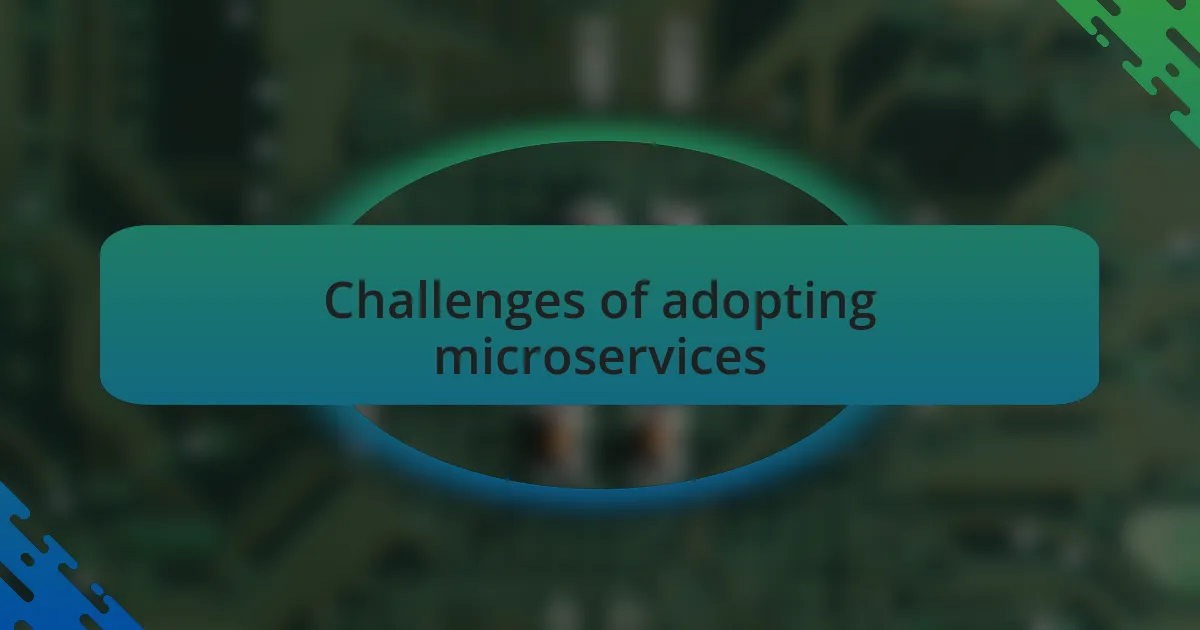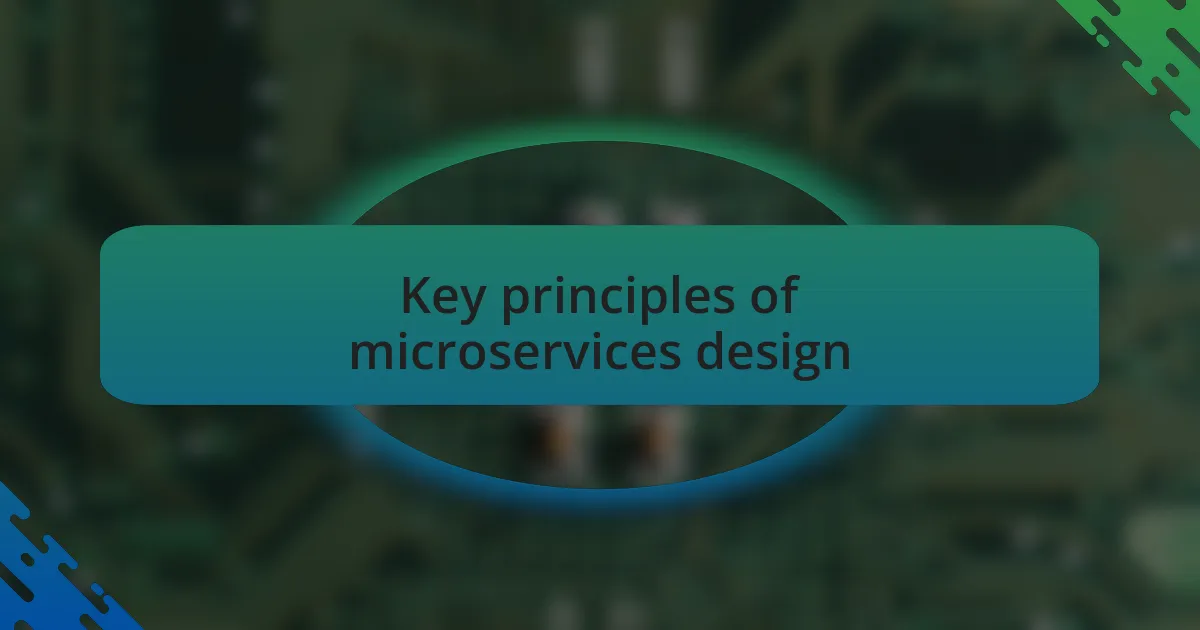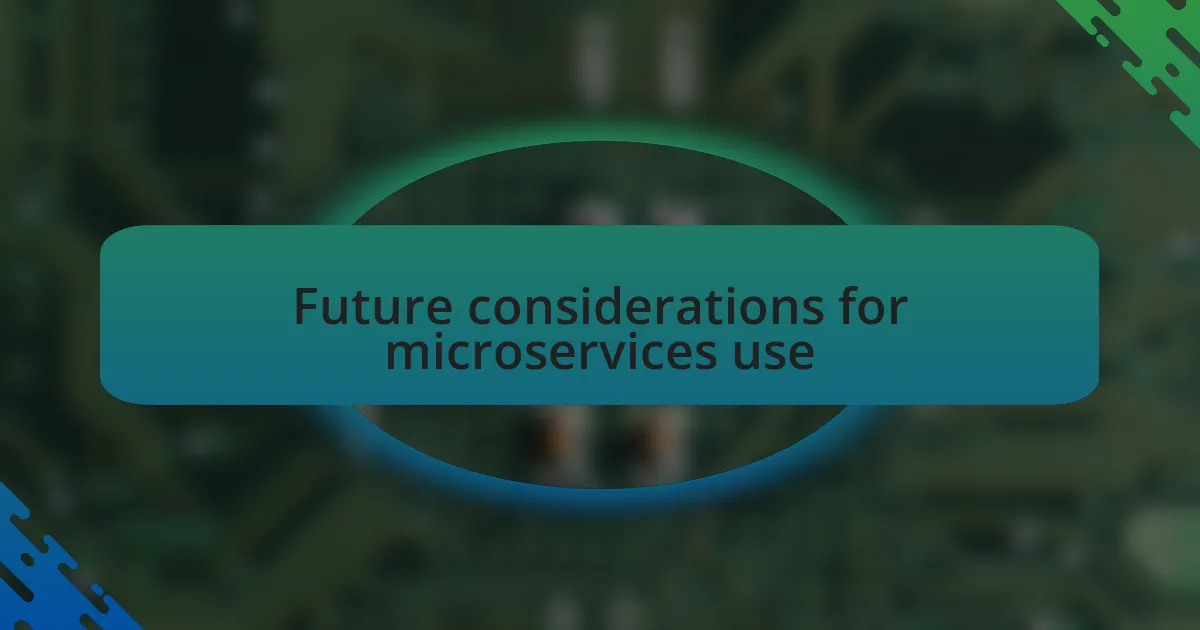Key takeaways:
- Microservices architecture enables independent development and deployment of small services, enhancing flexibility and delivery speed.
- Key challenges include managing inter-service communication and ensuring data consistency across services, requiring careful orchestration.
- Successful microservices adoption demands clear service boundaries, a strong DevOps culture, and effective monitoring tools to drive improvement.
- Future considerations involve proactive scalability strategies, a culture of continual learning, and integrating robust security practices into service design.

Understanding microservices architecture
Microservices architecture is a way of designing software applications as a collection of small, independently deployable services. Each microservice focuses on a specific business capability, allowing teams to develop, test, and deploy them separately. This modular approach not only enhances flexibility but also accelerates delivery, which I’ve personally found vital in today’s fast-paced development environments.
Thinking back to a project where we transitioned from a monolithic architecture to microservices, I was amazed at how much easier it was to isolate issues. When a small service failed, we didn’t have to bring down the entire application. Instead, we could address the problem quickly without disrupting other services. Have you ever experienced a situation where downtime felt unbearable? This architecture minimizes those moments, making it a game-changer for reliability.
Despite the benefits, adopting microservices isn’t always straightforward. I’ve seen teams struggle with managing the complexity that comes with it—like how to ensure seamless communication between services. It begs the question: How do we maintain coherence without sacrificing the agility that microservices offer? The answer often lies in robust orchestration and service discovery methods, which can make all the difference in harnessing the true power of this architecture.

Benefits of microservices in development
One of the standout benefits of microservices in development is the enhanced scalability it offers. In my experience, scaling an application that uses a microservices approach is like having a toolbox where you can pick and choose the exact tools you need for the job. I remember a project where we had to unexpectedly handle a surge in user traffic, and instead of scaling the entire application, we just expanded the specific microservice that managed user requests. It was a smooth process that not only kept performance steady but also saved us significant resources.
When it comes to team organization, microservices can revolutionize the way developers collaborate. I recall working in a team where each microservice was owned by a different group. This ownership fostered a more responsible culture; I could see how developers took pride in their service’s performance. It leads to quicker iterations and more ownership over individual pieces of the system. Have you noticed how accountability can spark innovation?
Moreover, a major appeal of microservices is their ability to facilitate continuous integration and deployment. I often chuckle when I think back to our old pain points with long release cycles; now, with microservices, each team can release updates independently without waiting on a massive deployment schedule. It’s refreshing to see how this helps not only in keeping the codebase agile but also in deploying features that our users actually want—quickly! What’s more satisfying than delivering value to users faster and more frequently?

Challenges of adopting microservices
Adopting microservices isn’t without its hurdles. One challenge I faced was the complexity of managing inter-service communication. I once worked on a project where a simple data exchange turned into a tangled web of network requests, leading us to question whether the benefits truly outweighed the complications. This experience made me realize that while microservices offer flexibility, they also require careful design and orchestration to ensure seamless communication between services.
Another significant challenge is data management. In my previous role, I encountered issues with maintaining data consistency across multiple services. We often debated whether to use a single database or go for database per service. It’s a delicate balance. I found myself pondering: how do you ensure that the right data is available to the right service at the right time? This kind of complexity can make even seasoned developers feel overwhelmed, leading to frustrations and misunderstandings within the team.
Lastly, I can’t stress enough the cultural shift required when moving to microservices. The first time my team made this transition, I noticed some resistance among colleagues who were more accustomed to monolithic architectures. The need for a DevOps mindset—where developers and operations collaborate closely—can leave some team members feeling uncertain. It’s vital to foster a culture of ownership and communication; otherwise, you may end up with silos where collaboration becomes a forgotten concept. How does one ensure that everyone is on the same page, especially when facing such transformative changes?

Key principles of microservices design
When considering microservices design, one of the fundamental principles is the concept of bounded context. I remember working on a project where we meticulously defined the boundaries of each service. This helped us avoid overlapping responsibilities and clarified ownership. The clarity gained from these boundaries not only improved our development speed, but it also reduced the likelihood of conflicting changes. It’s fascinating how a well-defined context can lead to both better communication and a more manageable architecture.
Another crucial principle is the emphasis on decentralized data management. In one project, we decided to allow each microservice to manage its own database. Initially, it felt daunting, as we were used to centralized databases. Yet, I quickly realized that this approach empowered teams to innovate independently. It raised a valid question: how do you maintain data integrity across services without a central authority? Through careful event sourcing and the eventual consistency model, we found a path that granted us agility while still respecting the complexities of data management.
Lastly, designing for failure is something I have come to value deeply in microservices architecture. During a high-traffic event in one of my projects, a single service failure caused cascading issues throughout our system. It was a tough lesson that taught me the importance of resilience patterns, like circuit breakers and retries. I often reflect on this: how do we prepare for the unexpected? Establishing robust monitoring and alerting systems alongside a culture that doesn’t panic during failures is essential. Embracing this principle not only reinforces our ability to recover but also fosters a more confident approach to building resilient systems.

My experiences with microservices
My journey with microservices has been a blend of triumphs and challenges. One project stands out where we transitioned from a monolithic structure to microservices. I vividly remember the initial chaos; integrating different services felt overwhelming. Yet, when our team successfully deployed updates independently, I experienced this exhilarating sense of freedom. It made me ponder: isn’t it incredible how breaking down a monolith can lead to such empowering autonomy?
In another experience, I faced the reality of inter-service communication. We implemented RESTful APIs, but during testing, I realized how essential it was to handle network latency gracefully. One particularly frustrating day, a timeout in one service caused delays that rippled through our entire system. It really struck me — how do you balance seamless communication while maintaining independence? From that moment, we began adopting asynchronous messaging to decouple interactions, and honestly, it felt like a weight was lifted.
Lastly, I encountered the stark truth about operational overhead. While microservices promised agility, I found myself swimming in the complexity of maintaining multiple deployments and monitoring tools. It raised a challenging question for my team: how do we embrace this complexity without sacrificing our productivity? By fostering a culture of shared responsibility and investing in automation, we slowly transformed the chaos into a streamlined operation. This experience was a reminder of how critical it is to strike that balance between innovation and operational sanity in the microservices landscape.

Lessons learned from microservices adoption
Transitioning to microservices brought several important lessons that shaped my perspective on software development. One key takeaway was the significance of clear service boundaries. Early on, I learned the hard way that not defining boundaries led to overlaps and confusion. I often found myself asking, “Which service owns this responsibility?” and realized that clarity in service ownership is vital to avoid unnecessary complications down the line.
Another profound lesson came when we implemented monitoring tools across our microservices. Initially, I believed that just having the tools in place would suffice. However, I quickly discovered that without proper alerting thresholds and actionable insights, those tools became noise rather than valuable resources. That experience made me reflect: How can we gather data in a way that genuinely drives improvement? It taught me the importance of tailoring monitoring to truly reflect our team’s goals and pain points.
Also, the journey reinforced the value of a strong DevOps culture. At first, I underestimated how crucial collaboration between development and operations would be. I remember the frustrations of deployment hiccups that could have been avoided if teams communicated better. That realization led to fostering a collaborative environment, turning our initial hurdles into a cohesive and adaptive team. Isn’t it amazing how sometimes the soft aspects of a project can have the most profound impact?

Future considerations for microservices use
As I look toward the future of microservices, scalability has become a pressing consideration. It’s not just about handling current loads; it’s about anticipating growth. I recall a project where we overlooked scalability, leading to system crashes during a traffic surge. Would we have been better prepared with proactive scaling strategies? Absolutely. Integrating a strategy that anticipates higher demands can ultimately save teams from scrambling at the last minute.
Another point I find crucial is the need for continual learning and adaptation. With ever-evolving technologies, I believe it’s essential to foster a culture of experimentation. I remember a time when we hesitated to adopt a new orchestration tool because it seemed daunting. Once we took that leap, it significantly enhanced our workflows. Are we ready to embrace change and learn from it? I think the willingness to iterate and adapt is key to maximizing microservices benefits.
Furthermore, I think about the security implications of microservices. As we decentralize our systems, do we have robust security practices in place? In one instance, a minor oversight exposed vulnerabilities we hadn’t considered before, highlighting that security needs to be baked into each service from the start. Emphasizing security as a fundamental part of development, rather than an afterthought, will be crucial as we move forward.